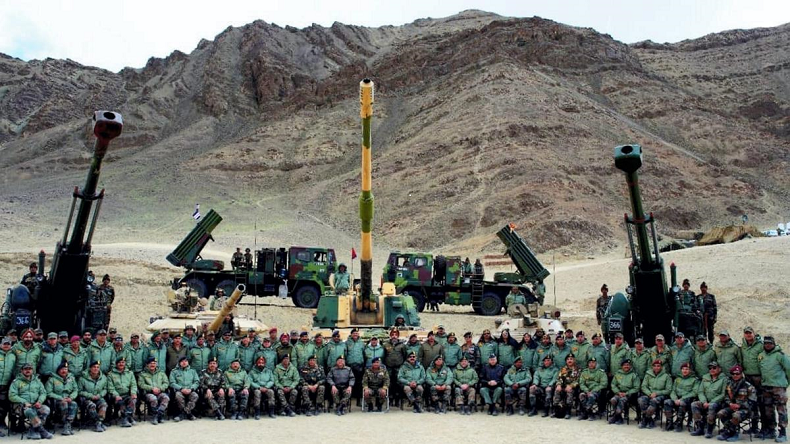While Indian and Chinese soldiers are respecting the contours of the mutually agreed buffer zone in other places, these specific areas remain unresolved.
Despite gradual improvements on the India-China border since the clash at Galwan on 15 June 2020, which occurred three years ago, the unresolved issues at Demchok (Eastern Ladakh) and Depsang (Northern Ladakh) continue to linger. While Indian and Chinese troops are respecting the contours of the mutually agreed buffer zone in other places, these specific areas remain unresolved.
The Chinese People’s Liberation Army (PLA) troops, while going back to their side of the Line of Actual Control (LAC) in all other regions, are reluctant to apply the same wisdom in these two areas (Demchok) and (Depsang) and are continuing to restrict the patrol movement of Indian troops to patrol points where they would go earlier.
India claims both these areas as something which falls inside its territory, something that China is refusing to accept in a region where almost nothing is demarcated on the ground and claims and counterclaims are made on the basis of which of the two forces were patrolling the area traditionally.
China wants India to accept the status quo and “move on”, something that the Indian side is not going to accept. Sources said a “state of heightened activities” was how things can be described in these two regions. The “positive” thing, sources said, was that talks have not been discontinued on the ground and that shows that both sides want to establish normal ties and China has realised that its unilateral attempt to change things on the ground by sending troops is not acceptable and will not go unchallenged.
India, sources said, wants the Chinese side to go back to the points where it used to be earlier and thereby make it clear that it does not want to usurp unclaimed territories, something that has led to the present situation and forcing Indian troops to respond in the same manner.
The 3,488 km India-China border is divided into three sectors namely—Western sector (1597 km), Middle sector (545 km), and Eastern sector (1346 km). The Western sector consists of Jammu & Kashmir (also Ladakh), the Middle sector comprises Himachal Pradesh, Uttarakhand, while the Eastern sector consists of Sikkim and Arunachal Pradesh.
Official sources told The Sunday Guardian that complete disengagement has been achieved and a mutually acceptable buffer created in Galwan, Gogra, Hotsprings and Pangong Tso (Eastern Ladakh). All these areas had since June 2020 witnessed eyeball to eyeball confrontation between Indian and Chinese troops at some point or the other. The other incursion that has not been ignored by the Indian side is Chinese troops entering Western Bhutan at the Amo Chu river valley. Apart from violating Bhutan’s sovereignty, Amo Chu is adjacent to the strategic Doklam plateau, from where India’s Siliguri corridor is in the direct line of sight. It is also a few km from the crucial India-China-Bhutan Doklam tri-junction.
According to officials, PLA’s 8th and 4th combined brigade is stationed in the Western sector combining 50,000 plus border troops. Two divisions—5th and 6th—are deployed in the Eastern sector. In Arunachal Pradesh, no further incursion has been attempted by the PLA.
What has stopped the Chinese from sending its troops to more unclaimed and non-patrolled areas is the possibility of coming across Indian troops and the inevitability of such adventures by Chinese troops turning into a major conformation as now much more such areas are being claimed by India and being patrolled. These areas were left untouched by India so far on a good faith that it will be claimed neither by them nor by the Chinese and hence acted as an informal buffer zone.
However, after being back-stabbed by the Chinese, Indian policymakers have been investing massively to augment its capabilities, both military and infrastructure, in the region.
India’s capability to transport troops and men has increased four times since the start of 2022 because of road constructions, sources told The Sunday Guardian. The budget of the Border Road Organization (BRO) has been increased 40% since 2022. In 2020, it was Rs 5,684 crore, in 2022 it is Rs 13,500 crore. Sources said that since 2015, a total of 5,994 km of road have been built by BRO while keeping Chinese expansionism in mind. These roads classified as India–China Border Roads (ICBR) are divided into ICBR-1 and ICBR-II. While ICBR-I has 73 roads of which 61 are being built by BRO, the ICBR-II has 41 roads, 21 of which are being built by BRO.
Significantly, a total of 19 new airfields have been constructed or revived in the last couple of years that has led to a massive increase in the ability to transport men and machines from one place to the other at a very short notice. The Indian military is now operating Advanced landing grounds in Chushul, (Leh, Ladakh) DBO (North Ladakh), Nyoma (South Ladakh) that have given strategic airlifting capabilities to the troops.
The heavy lift US made CH-47 Chinook helicopters, 15 of which were bought between February 2019 and May 2020, have added the extra power to the Indian Air Force as it is capable of delivering heavy payloads to high altitudes.
Similarly, the enhanced focus on road projects that are being completed in Jammu and Kashmir has led to a reduction in the time taken by the Indian army to transport essential machines to crucial points at a short notice.

